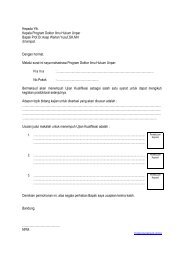TOWARDS CLASSIFYING CLASSICAL BATIK IMAGES - Unpar
TOWARDS CLASSIFYING CLASSICAL BATIK IMAGES - Unpar
TOWARDS CLASSIFYING CLASSICAL BATIK IMAGES - Unpar
You also want an ePaper? Increase the reach of your titles
YUMPU automatically turns print PDFs into web optimized ePapers that Google loves.
appears clearly. By enhancing the images and using a certain threshold value (in this experiment,<br />
it is 0.5) to Canny detector, isen-isen is sometime eliminated from the edges giving better<br />
shapes.<br />
a.banji b. ceplok c. lung-lungan d. semen<br />
Figure 5. Batik edges detected by Canny detector.<br />
It also is found that the output of Canny detector applied to batik images having fine motif is fine<br />
and dense edges (see Fig. 6). Applying the methods mentioned previously to generate shape<br />
features from these edges would potentially give bad or erroneous features. Generating texture<br />
feature from this kind of image is more appropriate.<br />
Figure 6. An example of Canny output having fine and dense edges.<br />
Conclusion<br />
Image preprocessing of classical batik images plays an important role in generating the<br />
appropriate features that could lead to high accuracy result of the classification. As there are<br />
many batik images containing large and small shapes of ornaments, generating feature for both,<br />
in the form of shape and texture feature, would be needed by the classification technique in order<br />
to increase the accuracy. Further work is needed to prove that the classification technique<br />
proposed performs well. The work would include implementing the system and conduct<br />
experiments, with the aim of observing the performance of the technique, using large number of<br />
images representing real world batik images.<br />
7




